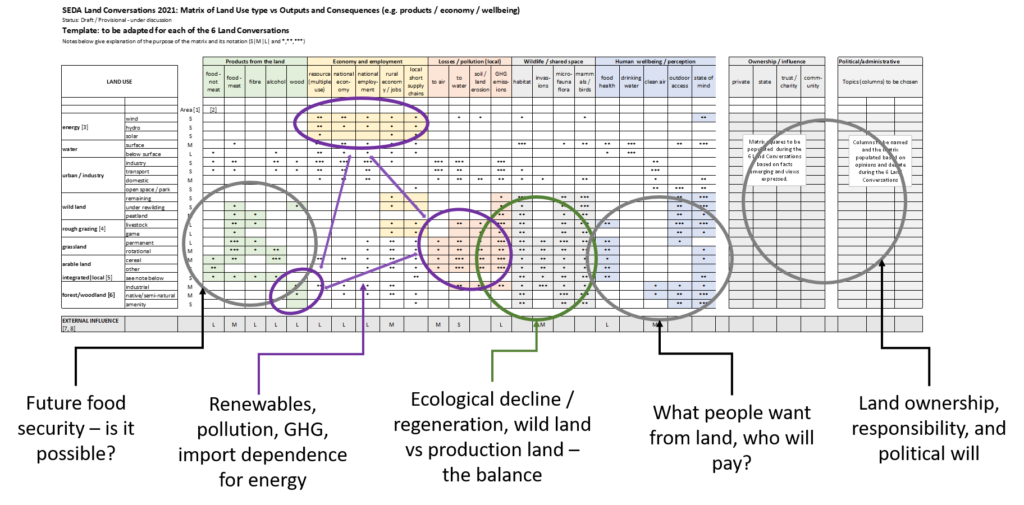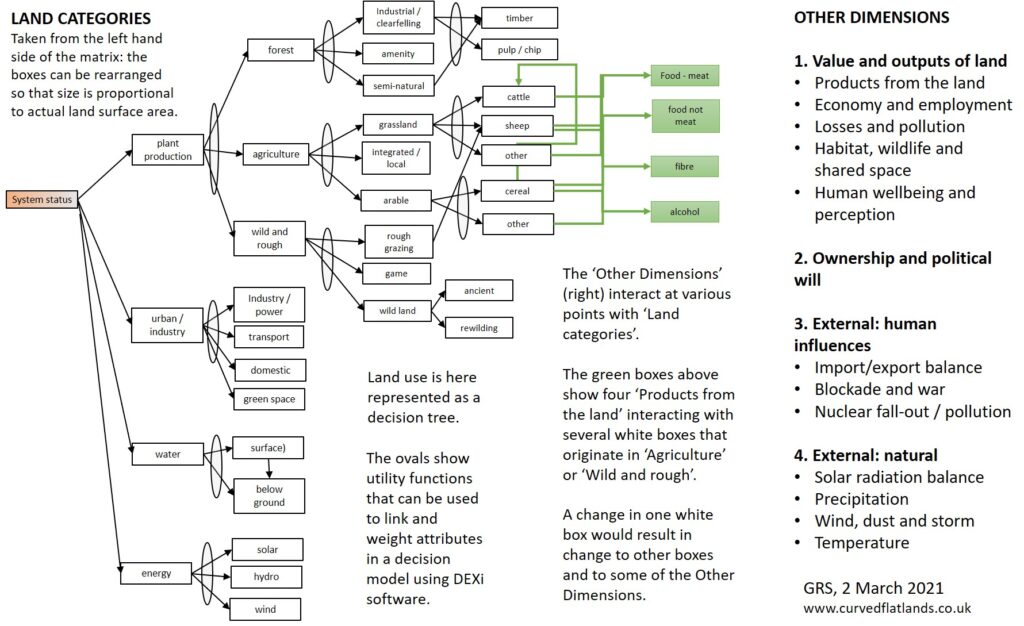Ecosystem stores and fluxes. Local-scale exchanges of energy and matter. Human as well as Biophysical stores. The threat of the big global flux. The basis of a computer game.
SEDA Land [1] – a part of the Scottish Ecological Design Association (SEDA) – has been working with students at the University of Abertay Dundee [2] on a computer game in which- after catastrophic events – communities are striving for survival.

Figure 1. The Ring of Brodgar, Orkney, built by early settlers who tilled the soil and grazed pasture, opening the way to today’s agriculture. Soils and essential biodiversity are degrading here, but it’s not the dust bowl yet. Images by Squire, inset shows a record (LP) cover – Dust Bowl Ballads by Woody Guthrie (more below).
In the game, the communities have to provide a minimum of three things from the land – food, shelter and power. They have to grow crops, grass and livestock, make houses and barns from rock and trees, and generate power from turbines and other sources.
Land is in short supply. The communities have to work together or they fail. But there’s something else – a recent cataclysm opened portals to the other side. Standing stones, some with obscure icons carved into them, appeared in the landscape. The ‘veil’ thinned and fantastical creatures passed through, some to help the communities, some to cause mayhem. How will they cope!
Well the first thing (GS said) is to understand ecosystem stores and fluxes [3], first the real, then maybe the metaphysical. Here we look at stores and fluxes at two scales. But first a quick look at another portal, described in a work of poetry by Dante and portrayed by the artist William Blake [4].
From William Blake‘s illustrations of Dante‘s Divine Comedy, Inferno III [4] as Dante and Virgil are about to step through Hell-Gate (from one world to another), where they come across the tortured souls of the INDIFFERENT (those who did nothing?).

Figure 2. At Hell-Gate, between one world of soft leafy trees and another where souls move forever along rising paths through red and blue shards (fire and ice – climatic cycles?). Image taken by GS at the Blake Exhibition, Tate Modern, London, January 2020 [4].
Store and flux at local scales
All ecosystems are subject to large environmental ‘fluxes’ that are essential for life, but that can destroy life if not regulated. Most land-based ecosystems build a ‘store’, which consists of soil, plants, microbes, invertebrates, higher animals, and the ‘dead’ organic matter produced when these organisms shed tissue or die. The organic matter is ‘worked’ by the living things into forms that bind soil particles and hold water and the nutrients essential for life.
The main inward fluxes (Fig. 3) are of solar radiation, water, and in some cases deposition of dust, ash and chemicals carried by moving air. The store processes these fluxes to enable (for example) photosynthesis by plants in which carbon dioxide from the air is converted to plant matter, and fixation of nitrogen from the air by a symbiosis of soil microbes and roots.

Figure 3. Diagram representing ecological stores (in the box) including soil (mineral particles, dead organic matter, etc.) and living matter (plants, microorganisms, invertebrates, etc.), and fluxes of energy and matter into (black lines) and out of (orange lines) the store. Based on Squire & Hawes, 2024 [3].
The main outward fluxes (Fig. 3) are long-wave radiation from the plants and soil that have been warmed by solar energy, evaporation of water (termed transpiration when this moves through plants), gaseous emissions to the air from breakdown of organic matter, further loss of water and materials as surface runoff and drainage to bedrock, and the loss of store particles by the same forms of air movement that also deposit material.
For a system to have resilience, its stores and fluxes have to be balanced. The store must regulate the fluxes to survive. It mostly does so in a natural system. But when people came to use the land, to cut trees, grow crops, and graze animals, they added two extra fluxes: inputs such as cultivation, controlled burn, new seed, livestock, fertiliser and more recently big machines; and offtake of material for food, clothing and timber.
Over time, the inputs and offtake have become so large that they commonly lead to imbalance in the system, generally to its detriment. While managed ecosystems can in principle last for many thousands of years, they can also be destroyed in a few decades by mis-management. Imbalance in store and flux and subsequent destruction of the store for short-term gain, whether intended or through ignorance, is named extractivism. The US Dust Bowl is a classic example (Fig. 4).
From the Dust Pneumonee song by Woody Guthrie
I went to the doctor and the doctor said my son (repeat), You got that Dust Pneumonee and you aint got long, not long.
My good gal sings the Dust Pneumonee Blues (repeat), She loves me cos she’s got the Dust Pneumonee too.

Figure 4. Cover of the classic Woody Guthrie record of songs about the US Dust Bowl released by Folkways some decades ago. The people most affected by such environmental catastrophe are usually the poorest, the vagrant, not those who encourage the change or set the policy. The words above left are from one of the songs; those below from inside the record sleeve [5].
The pioneering ax and plough rapidly upset the interplay of natural forces that had formed and preserved rich soils ….. The same tide that rolled the frontier forward from the Atlantic rolled back nature’s stabilising mantle of trees and grasses and bared virgin soil to weathering.
John Asch
But something is missing from Fig. 3 – the knowledge and experience that people have in managing land is also part of the store …. and no matter how good the management, the store can be affected by distant forces.
The store of knowledge, continuity and community
The diagram in Fig. 3 therefore represents only one part of a managed ecosystem. The other part of the store is held by the People that live and work on the land (Fig. 5). The People not only give to and take from the biophysical store but they form an additional store in terms of their knowledge, experience and social connections.

Figure 5. Diagram to represent an ecosystem in terms of its biophysical components and its communities of people (orange boxes), both under constant threat from large global fluxes, here divided into Biophysical and Human (blue boxes).
Probably more so that at any other time, ecosystem stores are now under threat from extractivism. Inputs and offtake have become so great that they dominate the store. This need not be, and we can learn from those examples of successful stewardship.
Yet well managed systems are under threat from things well outside their control. In talking to the Abertay students, these threats came to be called ‘Big Fluxes’ (Fig. 5).
Threat of the Big Flux
The Big Fluxes can be divided broadly into those having Biophysical and those having Human causes. The Biophysical, such as volcanic eruption, tsunami, flooding, and cycles of global cooling and warming, are outside the control or influence of any parcel of land and its people. Many of the Human causes are also outside local control – take war, blockade, nuclear fallout and the acts of occupying ideologies to force mass starvation and genocide. In some cases, the controlling hands are physically closer to the scene – take the evictions and clearances that depopulated rural Scotland in the 1700s and 1800s.
But some Biophysical forces can in principle be influenced by Human intervention, both inside and outside the land in question. For example, disease epidemics (and pandemics) may have originated well outside the land, but their spread to and within the land could have been limited, more than they have been recently, through better understanding of the infection process and more effective control.
Can anything be done to make the local stores and fluxes in Fig. 3 resilient to a Big Flux? To a degree it can, for some of the Big Fluxes. For example, if agricultural or grazing land is denuded of perennial vegetation, its soil over-cultivated or over-grazed, the organic matter allowed to degrade and the surface left exposed, it will suffer more under flood and storm than if it was properly cared for (Fig. 6). And fire-prone forest and bush can to a degree be protected by creating breaks and reducing the store’s burnable material.

Figure 6. Erosion gulleys like this form in many parts of the world, mainly when gradual soil degradation over a long period (which may be unnoticed) is scaled up to catastrophic erosion during extreme rainfall and flood. Most organic matter, including roots, in the photograph above occupies the upper 10 to 20 cm of soil (short vertical bar). Some roots, mainly of the shrubs, can penetrate the red soil layer to 0.5-1.5 m (long vertical bar). Arrows show the ends of roots exposed after the collapse of the soil into an erosion gulley 5 m deep. Photograph by Squire, south-east Asia, 2014.
Forgetting the Big Fluxes
The situation that needs to be faced, in reality and in the game, is that People forget about the Big Fluxes. There will be another, there’s no doubt, but People fail to prepare for it.
Some Big Fluxes are so infrequent that generations, sometimes centuries, even millennia, pass without experience of them. The last major tsunami to hit Scotland was thousands of years ago and the last volcano to throw its ash this way was Laki, in Iceland in 1783-84.
Others Fluxes are more frequent but governance repeatedly fails to act. In Scotland, and in the UK as a whole, home-grown food production fell well short of feeding the people in the run of bad-weather years in the late 1870s. Rather than giving long-term technological support for agriculture, the government filled the void by importing food from north America, leaving agriculture to suffer and its people to leave the land.
A few decades later, and in the face of blockades in 1914 and 1939, the country again had to rely on imports. Even now when its advanced agricultural technology could in principle feed the people, it would still fall well short in a face of blockade. Extreme climatic events elsewhere could have the same effect. Imagine that drought destroyed the vegetable harvest in Spain and north Africa. Where would the UK get its veggies from?
So ‘memory’ of the big fluxes needs to kept by people, by their communities and in their shared history.
It’s a game
How is all this going to be realised in a computer game? Well not all of it, at this point, but things like soil, vegetation, livestock, rock and power sources can be represented spatially. People have a choice as to whether they build their stores and extract materials sensibly, or let them degrade and ultimately fail.
They might be succeeding, and all looks good, but then what’s the chance of a Big Flux! Can other forces help them? It’s a work in progress.
Further information on soils, agroecological farm practice, early game plans, Pictish art, livestock and related topics discussed with the Abertay students can be found on subsequent pages of this post listed after Sources | Links.
Author | contact: For this article: geoff.squire@hutton.ac.uk or geoff.squire@outlook.com. For SEDA Land and development of the game: gail@halvorsenarchitects.co.uk. Lorna Dawson at SEFARI Scot gave ideas and information on a range of topics: lorna.dawson@hutton.ac.uk.
Sources | Links!
[1] SEDA Land: https://www.seda.uk.net/seda-land
[2] Abertay University: School of Design and Informatics
[3] Store and flux and related agri-ecosystem processes are described in a book chapter to be published ‘open access’ in August: Squire GR, Hawes C (2024). Biodiversity for Agriculture – the role of integrated farm management in supporting agriculture through biodiversity. In Managing Biodiversity in Agricultural Landscapes. Burleigh Dodds Science Publishing.
[4] William Blake (1757-1827) made many illustrations based on events in the Divine Comedy by Dante (1265-1321). Some were shown at an exhibition William Blake at Tate Modern in 2019-2020 and the complete set is now available in a book – Schutze S, Terzoli MA – William Blake – Dante’s Divine Comedy – The Complete Drawings, published by Taschen. The Divine Comedy is available in paperback and in online translations at Project Gutenberg and Digital Dante.
[5] Dust Bowl Ballads by Woody Guthrie, Folkways Records, 1964: see Smithsonian Folkways. More on the Dust Bowl at livingfield web: Dust Bowl Ballads which includes links to the pioneering work on soils by Hugh Hammond Bennett, e.g. Bennett HH, Chapline WR. 1928. Soil erosion a national menace. Circular No. 33, United States Department of Agriculture.
[6] William Blake and the Dust Bowl were both referred to in an earlier presentation and web resource viewable on the curvedflatlands web at Soil: healing the skin. The healing remedies include Bandage (e.g. coverings) and Ointment (e.g. exudates and other organic matter from grass-crop-tree mixtures). Click for a PDF file of the presentation.
Continued …..
Further background to a range of topics discusssed with Abertay students over the last few month – click on the page number links at the bottom.
Page 2 More on soil degradation under agriculture and forestry and ways to avoid it by Lorna Dawson and Geoff Squire.
Page 3 Early project ideas and descriptions offered to the Abertay students by SEDA Land and James Hutton Institute (Geoff Squire, Lorna Dawson, Gail Halvorsen and Pete Iannetta).
Page 4 Pictish art – some standard books and links to active groups and people.
Page 5 Sheep, cattle, walls and fences – including examples of ancient breeds.

























